

Why Dealers Can Be Indifferent If They Can't Fix Your New Car Under Warranty. Many consumers are baffled by the indifference they encounter from dealers who are unable to repair new cars under warranty.

Buyers spend a ton of money on a new car–and are treated like royalty during the buying process–but once they show up in the service department? It seems the dealer doesn’t seem to care when the recurring problem cannot be pinpointed or repaired. I’ve spoken to countless consumers who were surprised by the Jekyll/Hyde difference between the front of the dealership and the back. But there is a very real reason why dealers seem to give up on the troublesome cars. It is a result of Lemon Law. All 50 states have some form of Lemon Law which mandates that manufacturers must buy back or replace fatally flawed cars.
Everyone knows the cars are built by car companies and sold by car dealers. But repeated warranty repairs? This odd set of facts and circumstances can lead to some interesting and comical results. Steve Lehto is a writer and attorney from Michigan. When Can Your Car Dealer Void Your Vehicle's Warranty or Deny Auto Warranty Service Claims? Don't let the dealer sweep your warranty claim under the rug just because someone else does your oil changes or if you use parts not sold by them March 19, 2019.

Dealing with your car dealer on repairs and warranty work. There are good and bad dealers within any brand, from Acura to Volvo.
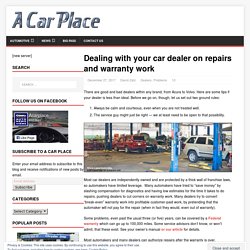
Here are some tips if your dealer is less than ideal. Before we go on, though, let us set out two ground rules: Always be calm and courteous, even when you are not treated well.The service guy might just be right — we at least need to be open to that possibility. 12 Safety Tips for Your Next Road Trip. If your next vacation is a road trip, then be prepared: Your car is about to become a mobile family room.
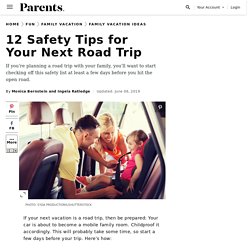
Childproof it accordingly. This will probably take some time, so start a few days before your trip. Here's how: Safe Driving Tips for Gravel Roads. 4 Tips for Driving on Unpaved Roads. Safe Driving on Gravel Roads - Arrive Alive. Introduction Many licensed drivers have never driven on gravel roads or are inexperienced and unprepared for the unique challenges when doing so.
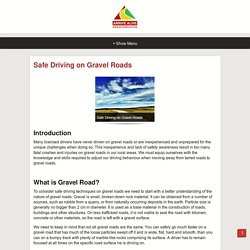
This inexperience and lack of safety awareness result in too many fatal crashes and injuries on gravel roads in our rural areas. Most Common Car Accident Injuries & How to Avoid Them. How to Avoid or Lessen Injury in Car Accidents. How to Prevent Whiplash with the Correct Car Headrest Setup. Rd. 14 Hacks to Deal with Snow and Ice on Your Car. Even people who love winter do not enjoy one of the season’s most unpopular jobs: clearing snow and ice off their cars.
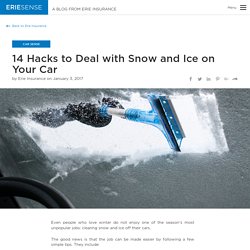
The good news is that the job can be made easier by following a few simple tips. They include: Turning on your front and rear defrosters as soon as you start clearing. If you have a push start, now is the time to take advantage of it. Give yourself more time than you think. The Dangers of Not Removing Snow From Your Car Windows. The Car Seat Lady – Top 10 Car Safety Tips. Posted in: Blog, Installation, Tips & Tricks 1.
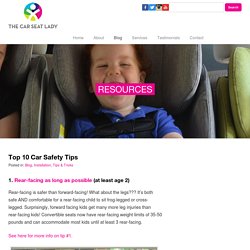
Rear-facing as long as possible (at least age 2) Rear-facing is safer than forward-facing! What about the legs??? Car Seats: Information for Families. One of the most important jobs you have as a parent is keeping your child safe when riding in a vehicle.
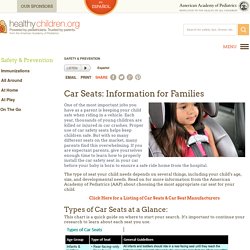
Each year, thousands of young children are killed or injured in car crashes. Proper use of car safety seats helps keep children safe. But with so many different seats on the market, many parents find this overwhelming. If you are expectant parents, give yourselves enough time to learn how to properly install the car safety seat in your car before your baby is born to ensure a safe ride home from the hospital.
The type of seat your child needs depends on several things, including your child's age, size, and developmental needs. Car Seat Safety Tips for Kids. When you have a child, a lot of your time is spent making sure your home is a safe place for them to be.
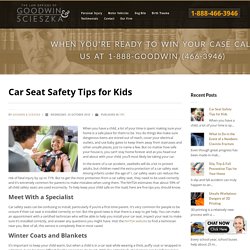
You do things like make sure dangerous items are stored out of reach, cover your electrical outlets, and use baby gates to keep them away from staircases and other unsafe places, just to name a few. But no matter how safe your house is, you can’t stay home forever and as you head out and about with your child, you’ll most likely be taking your car. In the event of a car accident, seatbelts will do a lot to protect adults, but children need the extra protection of a car safety seat.
Among infants under the age of 1, car safety seats can reduce the risk of fatal injury by up to 71%. How to Handle a Car Accident: A 7-Step Guide. An unexpected car accident can leave you feeling a bit scattered.
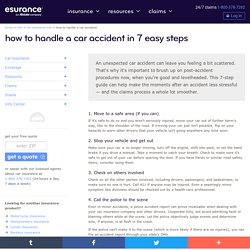
That's why it's important to brush up on post-accident procedures now, when you're good and levelheaded. This 7-step guide can help make the moments after an accident less stressful — and the claims process a whole lot smoother. 1. What to Do After a Car Accident {Guest Post} No matter how good of a driver you are, it’s still possible to end up in a car accident. Nobody ever leaves the house expecting to get into a car accident, but for thousands of people each year, that’s exactly what happens. According to the Michigan Office of Highway Safety Planning, there were 312,172 reported car accidents in the state of Michigan in 2016. Since car accidents happen so unexpectedly, even a minor one can be extremely overwhelming. What You Need To Know About Winter Tires. Back in the day, snow tires were called that for a very good reason: Unless the road was covered in snow, they were terrible.
Snow tires were sloppy handling and near-grip-free on dry and, especially, wet roads. A single emergency stop in the dry would ruin the tire's tread. Twenty years ago, as a test driver for a major magazine, I ripped whole tread blocks from a snow tire's tread in a single dry-road antilock brake (ABS) emergency-style stop. And that stop was roughly a third longer than the vehicle's original-equipment all-season tires took to stop. Later, as a test driver for a tire company, I found emergency stopping distances in the wet were sometimes hard to measure: A vehicle equipped with snow tires would still be moving as the wet test surface was about to end. That was then. "With top-quality winter tires you're no longer at the mercy of the weather or drivers around you," he says. As the thermometer falls, rubber stops being pliable. Low Tire Pressure is Not Safer in Winter Conditions. During the winter months, having properly inflated tires on your car is one of the best ways to stay safe on the road.
When conditions are snowy and icy, it’s important to make sure your tires are capable of maintaining traction with the road so that you can remain in control of your vehicle. But what is a proper winter tire pressure level? For a long time, a lot of people have thought that it’s good to lower your car’s tire pressure level in the winter because it will put more of the surface area of your tire in contact with the road, improving your traction. While this may work in some unusual circumstances, such as if you’re taking your vehicle off-roading, it’s not a practice that’s recommended for normal day-to-day driving.
Tire Tech Information - Remember These W.I.N.T.E.R. Tips. Winter Tech Information - Winter Maintenance Tips. Road Icing Myths and Frequently Asked Questions. This Q&A covers general road icing issues as well as some questions regarding implementing a National Weather Service-based road ice warning product. ALSO SEE: The Top 7 Icy Road Myths Aren't icy roads a visually obvious hazard that drivers have no excuse ignoring? A white, snowpacked road is not the picture of the typical high-fatality road icing hazard. Indeed, accident rates are lower when roads are completely covered in snow. In contrast, some of the worst icy road accident outbreaks occur with freezing precipitation (ZR and FZDZ), which creates road ice that is not visually distinguishable from wet roads.
Winter Driving Tips. Winter Driving Safety Tips: Black Ice Safety. Without a doubt, ice is one of the most dangerous types of weather conditions for drivers. Every year, it’s estimated that about 24% of all weather-related car accidents happen when pavement is snowy or icy. But ice poses a unique hazard because snow is at least easy to see and can provide some level of traction. Ice, on the other hand, doesn’t offer any traction for tires to work with and can be difficult for drivers to spot, especially when driving at night. Black ice is a particularly dangerous hazard drivers have to watch out for. While some ice patches are visible, the term “black ice” refers to a smooth layer of ice that tends to blend right in with the pavement.
Since black ice is so hard to see, one of the best things you can do is try to avoid it and that means knowing where and when it’s most likely to form. When it’s cold enough for ice to form, try to stick to well-trafficked roads since the heat from the vehicles can help melt ice. Winter Driving Tips. If you’re a member of the media and would like to schedule an interview with a AAA expert, visit NewsRoom.AAA.com for contact information.
Severe weather can be both frightening and dangerous for automobile travel. Motorists should know the safety rules for dealing with winter road emergencies. AAA reminds motorists to be cautious while driving in adverse weather. For more information on winter driving, the association offers the How to Go on Ice and Snow brochure, available through most AAA offices. Contact your local AAA club for more information. Fall Driving Safety Tips: How to Drive in Fog. When we think of weather conditions that are dangerous to drive in, the first things most people think of are the ones that make roadways slippery, like snow, ice, and rain. But since fog reduces visibility, it absolutely should be included in any list of dangerous weather conditions to drive in.
5 Essential Autumn Driving Safety Tips. Auto Insurance Quotes. Avoid These Mistakes: 5 Things NOT to do After a Car Accident. Car accidents can be very upsetting. How to Handle a Car Accident: A 7-Step Guide. After a Car Accident: First Steps - FindLaw. What should you do if you're in a car accident? When it happens, injuries may be severe and emotions high. What to Do After a Car Accident - NerdWallet. Accidents happen, even to careful drivers. 10 Statistics That Capture The Dangers of Texting and Driving.
On June 8, a report was released stating that Tennessee bus crash that left two young girls and a teacher’s aide dead last December was the result of texting and driving. James Davenport, the driver of the bus, was found dead in his home on June 1. While this story is tragic, texting and driving is far from unusual. A staggering 49 percent of adults admit to texting and driving, even though 98 percent of adults say they know the practice is unsafe. Below are 10 statistics that show how dangerous texting and driving really is. Number of Americans killed every day from motor vehicle accidents that involved distracted driving, such as using a cellphone, texting or eating. Texting and Driving Statistics - Distracted Driving Drives Up Risk.
Texting and Driving Facts. You wouldn’t smack yourself in the face with a hammer, would you? Of course not. Top 20 Safe Driving Tips. On the Road Safety Topics, Tips & Training from NSC.org. Millions of people drive as part of their jobs. Some are professionally trained drivers, many are not. If a job does not primarily involve driving, the employee often does not receive the same kind of safety management or engagement in driving safety that others may get.
Employers need to manage the safety of their employees on the roads, just as they manage other risks in the workplace. Start with an understanding of keeping employees safe. The NSC Journey to Safety Excellence incorporates leadership and employee engagement, risk management, safety management systems and measurement. Nobody knows driver safety training like the people who pioneered it more than 50 years ago. Off-the-job crashes account for 80% of employer crash-related health benefit costs, and half of crash-related injuries cause employees to miss work. To prevent motor vehicle crashes involving their employees on and off the job, employers should: Driving Safety. 10 Tips to Avoid Speeding Tickets. 6 Tricks to Avoiding Speeding Tickets Traffic Cop Tells All: How to Avoid Getting a Speeding Ticket (and Other Tips)